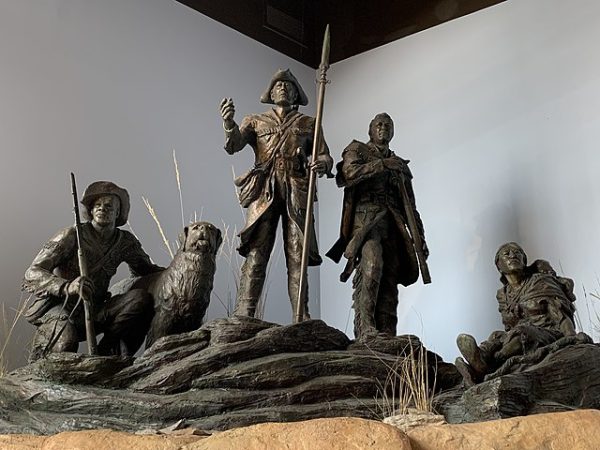
A bronze statue of a Newfoundland and Native American woman appears at the Cascade Locks Historical Museum in Marine Park, Oregon. Those who know their history will recognize the images as Sacagawea and “Seaman, ” the Newfoundland who accompanied Lewis and Clark on their mission to explore the Louisiana Purchase.
It’s hard to imagine Sacagawea’s life. Kidnapped at the age of 12 by a group of Hidatsa, a year later she was the wife of a Quebecois trapper. When pregnant with her first child, she was acting as an interpreter for Lewis and Clark and would have known the Newfoundland, Seaman. It’s fitting that the bronze pays tribute to them both, unlikely heroes of an epic journey.
“Seaman” attracted considerable attention. The Shawnees offered three beaver skins for the dog (the offer was declined), and a buffalo calf took such a shine to the dog that he followed along shore until the expedition party and Seaman disappeared from view in their boat.
Seaman was seriously wounded when a beaver bit him through the hind leg, cutting an artery. Lewis and Clark took extraordinary medical measures to save the dog, and remarkably, Seaman pulled through.Seaman had other adventures, though not much is written about him after the expedition was completed. One book published in 1814 reports that Seaman lived out his life with Meriwether Lewis. An Entry 916 of American Epitaphs and Inscriptions lists an inscription that was on a dog collar that had been donated to a museum in Alexandria, Virginia. The inscription read: “The greatest traveler of my species. The name is SEAMAN, the dog of captain Meriwether Lewis whom I accompanied to the Pacifick ocean through the interior of the continent of North America.”
Image of Lewis, Clark, York, Sacagawea, and dog Seaman by Robert Scriver is a monument located at the Lewis and Clark National Historic Interpretative Center in Great Falls, Montana and is in the Public domain

Lovely statues!
This young woman contributed in several important ways to the expedition. She was a sign to the tribes the expedition met that this was not a war party in their territory. They were traveling with a woman and her child. A war party would not bring along a woman with a baby.
When the expedition was in desperate need of horses to cross the mountains, by chance they came upon the tribe led by Sacagawea’s brother. When the siblings recognized each other, obtaining the needed horses was not a problem.
Had she not been along, this expedition, it might well have failed and disappeared in the wilderness.
Great comment, Yvonne, and it helps “flesh out” the picture we have of this remarkable young woman.
What was the secret between Sacagawea and Seaman?